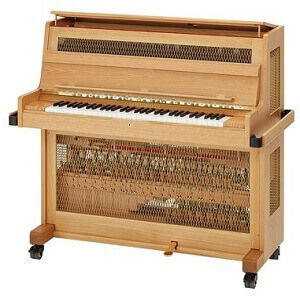Celesta
 The celesta (from the French “cèleste” for “heavenly”) is an idiophone with a keyboard which looks somewhat like a piano. The musical instrument celesta, also called celeste, was invented in 1886 by Victor Mustel.
The celesta (from the French “cèleste” for “heavenly”) is an idiophone with a keyboard which looks somewhat like a piano. The musical instrument celesta, also called celeste, was invented in 1886 by Victor Mustel.
A unique mechanism with a keyboard, felt hammers, sound plates and wooden resonators is crucial for the sound production. Although it is a keyboard instrument, the celesta belongs to the family of percussion instruments, but is usually played by a pianist.
The celesta was invented and patented in 1886 by Victor Mustel in Paris. The name celesta, which Victor Mustel created especially for this instrument, was already evident in the patent.
The unmistakable sound of the instrument is produced by its special mechanism: by pressing a key on the keyboard a felt hammer is triggered which strikes the top of a sound plate. Beneath the steel plate is a wooden resonator. The celesta has a pedal for damping and, as a transposing instrument, sounds an octave higher than notated.
The celesta instrument looks very much like a piano with a characteristic housing, a claviature and a single pedal. The housing contains an impressive mechanical system of felt hammers, special sound plates and wooden resonators.